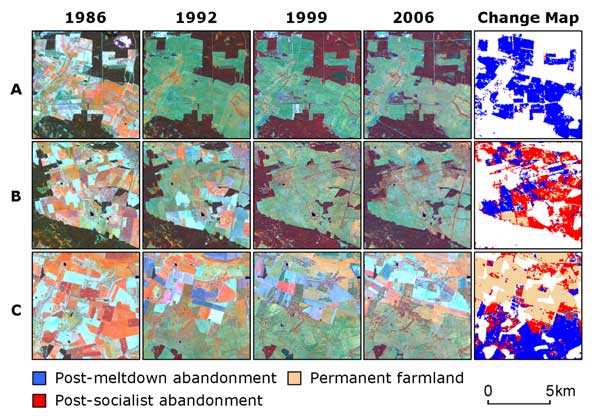Humans have transformed a large fraction of the Earth’s land surface. Over the past three centuries, the global extent of cropland has risen sharply, from around 2.7 to 15 million km2, mostly at the expense of forest habitats (Turner et al. 1990). Permanent pasture lands are even more extensive, reaching around 34 million km2 by the mid-1990s (Wood et al. 2000). The rate of land conversion has accelerated over time: for instance, more land was converted to cropland from 1950 to 1980 than from 1700 to 1850 (MEA 2005).
Globally, the rate of conversion of natural habitats has finally begun to slow, because land readily convertible to new arable use is now in increasingly short supply and because, in temperate and boreal regions, ecosystems are recovering somewhat. Forest cover is now increasing in eastern and western North America, Alaska, western and northern Europe, eastern China, and Japan (Matthews et al. 2000; MEA 2005). During the 1990s, for instance, forest cover rose by around 29 000 km2 annually in the temperate and boreal zones, although roughly 40% of this increase comprised forest plantations of mostly non-native tree species (MEA 2005). Despite partial recovery of forest cover in some regions (Wright and Muller-Landau 2006), conversion rates for many ecosystems, such as tropical and subtropical forests and South American cerrado savanna-woodlands, remain very high. Because arable land is becoming scarce while agricultural demands for food and bio fuel feed stocks are still rising markedly (Koh and Ghazoul 2008), agriculture is becoming increasingly intensified in much of the world. Within agricultural regions, a greater fraction of the available land is actually being cultivated, the intensity of cultivation is increasing, and fallow periods are decreasing (MEA 2005).
Cultivated systems (where over 30% of the landscape is in croplands, shifting cultivation, confined-livestock production, or freshwater aquaculture) covered 24% of the global land surface by the year 2000. Thus, vast expanses of the earth have been altered by human activities. Old-growth forests have diminished greatly in extent in many regions, especially in the temperate zones; for instance, at least 94% of temperate broadleaf forests have been disturbed by farming and logging (Primack 2006). Other ecosystems, such as coniferous forests, are being rapidly converted from old-growth to semi-natural production forests with a simplified stand structure and species composition. Forest cover is increasing in parts of the temperate and boreal zones, but the new forests are secondary and differ from old-growth forests in species composition, structure, and carbon storage. Yet other ecosystems, particularly in the tropics, are being rapidly destroyed and degraded. For example,marine ecosystems have been heavily impacted by human activities. The large-scale transformations of land cover described here consider only habitat loss per se. Of the surviving habitat, much is beingdegraded in various ways such as by habitat fragmentation, increased edge effects, selective logging, pollution, overhunting, altered fire regimes, and climate change.














0 comments:
Post a Comment